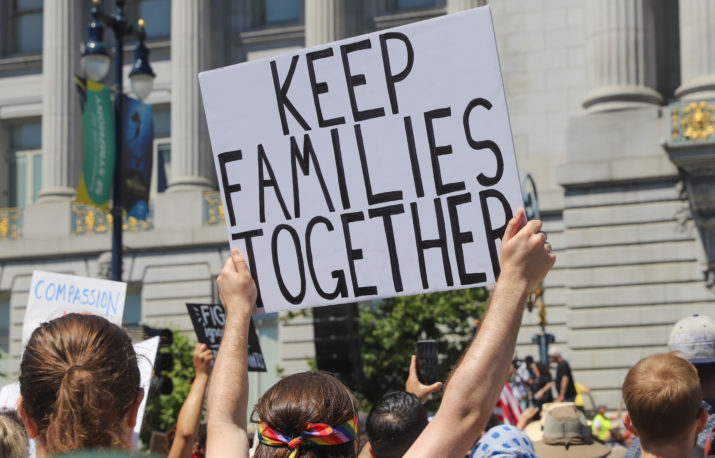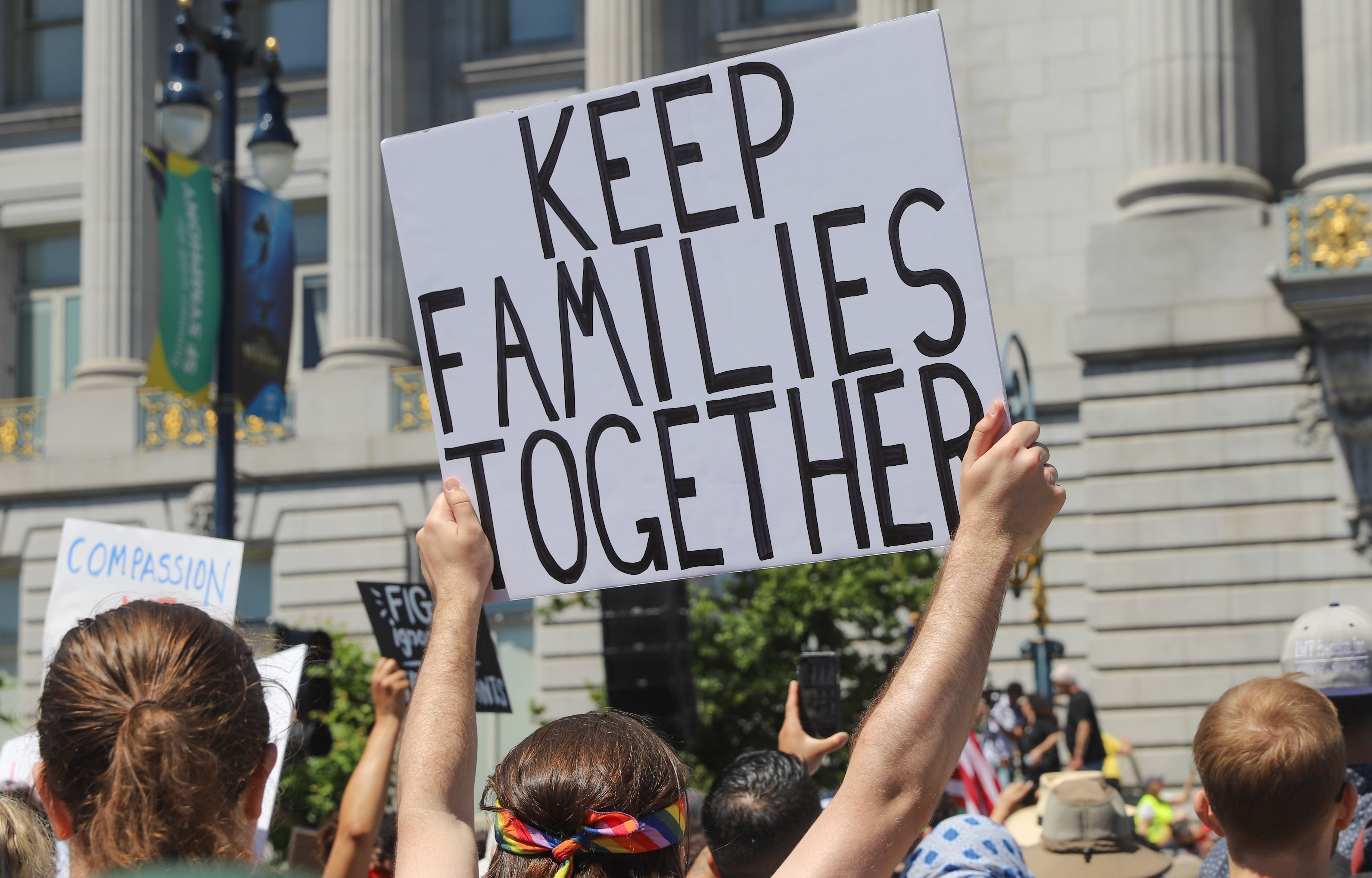

This is part of our special feature on Crime and Punishment.
The latest symbol of US immigration policy under Donald Trump is the “migrant caravan,” or more accurately, the procession of asylum seekers, largely from Honduras, currently making its way toward the US-Mexico border. President Trump seized upon the refugees—calling their by-foot ramble north no less than an “invasion of our country”[1]—reiterating his long held racial anxieties and fears about Latin American migrants, and heaping upon the travelers misinformation that would transform the desperation of people fleeing for safety into criminality and potential terrorism—all in time for the November midterm elections in the United States.
The fluctuating group of potential asylum seekers, which has grown larger and then smaller as it travels north, is characterized by a large presence of family units—most often women with children—that have been fleeing Honduras, Guatemala, and El Salvador through the last two administrations. They represent an ongoing exodus of persons fleeing the choke of economic and criminal perils, only drawn together deliberately for safety, visibility, cost-savings, and relative ease of travel. They have garnered support and pride and have also fueled old resentments. The last two US presidents sought to deter the individual and communal flights of Central Americans with stiff enforcement initiatives—Obama did so bureaucratically with a massive expansion of family detention in 2014 and Trump acted sensationally with family separation this past year.
Enforcement-first responses directed at potential asylum seekers are framed for the public as innovative and necessary responses to national crises. In 2014, for example, Obama’s Department of Justice operationalized the concept of the “national security threat” of “mass migration” to argue for the detention of women and children without bond—drawing from Bush administration decisions made in the context of 9/11-era anti-terrorism policies.[2] Trump also invoked the “crisis on our southern border,” dispatching the military to meet the “illegal caravans” and encouraging soldiers—and perhaps others who are listening—to answer rock throwing with rifles. “We have no choice,” Trump said, “We will defend our borders.”[3]
Repeated “Crises” of Family Detention
The problem with framing mass emigration of refugees and asylum seekers as one-off crises is that they demand one-off solutions—walls and fences, military deployments at the border, and deterrence that hinges on mass detention of families. These are status quo responses—inventing crimes in order to punish—that fail time and again, and create untold harm to persons seeking humanitarian relief protected by US and international law. The very movement of asylum seekers communally is a testament to collective suffering and long term structural and systemic problems that require long term solutions.
Family detention, in particular, is a strategic pawn that has been deployed in fits and starts. President George Bush experimented with for profit family detention with the T. Don Hutto Family Residential Center—a converted prison—during his administration, initiating wide ranging and widely condemned abuses against detained families with children. Obama closed Bush’s prison to families in 2009[4] only to expand the capacity of family detention in the US thirty-five times over to contend with a movement of Central American asylum seekers that was peaking in 2014.[5] And in Spring 2018, the Trump administration endeavored a new and short-lived policy—the “zero-tolerance” and consequent family separation policy—only to reverse course and return to family detention. All the administrations argued that their policies would deter future migrations north.
Currently, the Trump administration is seeking an even larger expansion of family detention, both in terms of bed space and length of stay, seeking to create administrative changes to long held court limitations—known as the Flores Settlement (1997)—on the detention of children. The administration’s proposed regulations seek an end-run around the twenty-day limit on child incarceration, permitting their indefinite detention through the entirety of court proceedings.[6] “We’re going to catch; we’re not going to release,”[7] Trump promises. The plan, sure to prompt legal action, would require a rapid and massive escalation of detention capacity. Concerned with costs rather than the safety of carceral conditions for families, Trump insisted, “We are not going to build structures and spend all of this, hundreds of millions of dollars… We are going to have tents.”[8]
Detaining families en masse might appear like a unique response to a distinct group of refugees and asylum seekers, but family detention is hardly new. Migrating families have been detained and processed together as long as they have been traveling to the US Family detention was utilized notoriously during the era of Japanese and Japanese American internment during World War II. It was used repeatedly in a series of Cold War refugee migrations and ad hoc resettlements from World War II to 1980 that included Europeans, Southeast Asians, and Latin Americans, usually arriving from communist nations.
Detaining families together is also a distinguishing strategy of the detention and deportation regime that is abundant with political currency. Under Bush, family detention was a botched experiment in punishment, a reform that would end “catch and release” under the guise of humanitarianism—to “keep families together.” When Obama ended the Bush experiment in the name of reform as well—to move toward a “truly civil detention system.”[9]—he demonstrated the pliability of family detention, converting Bush’s family prison to a women’s migrant facility and maintaining the relationship with its private prison operators despite recorded abuses. This pretense of reform was quickly abandoned when the Obama administration claimed that the “mass migration” of Central American asylum seekers was a “national security threat” and Obama would reshape family detention as an “aggressive deterrence strategy,”[10] meant to rebuff and dissuade claims.
Trump would inherit this system—including the kennel-like cages at Texas’s processing facility that drew public ire in Spring 2018—as well as the unprecedented efficiency of Obama’s (a.k.a., the “deporter-in-chief”) detention and deportation machine. Not to be outdone, after riding the issue of immigration to the White House, Trump added his own innovation with “zero tolerance” policing—criminally punishing the adults in migrant families with unlawful entry, thus forcing their separation from their children. With parents and children surrendering to authorities at ports of entry or when apprehended in order to seek asylum—a steady and cyclical movement of people ten years in the making—adults would be jailed and steered toward their subsequent detention and deportation and children would be processed and placed in the care of foster institutions, also with deportation as the end goal.
Trump’s family separation policies—deliberated, tested, and endorsed by the highest officials—wreaked havoc on a cohort of families with sensationalism and open, almost ignorant cruelty. The Trump administration invoked a so-called migrant crisis, at a time when border apprehensions are at their lowest level since 1971,[11] and then applied its own brand of bureaucratic chaos. Of the over 2,600 separated children, 220 remain in custody, and three fourths have been ruled ineligible for court-ordered reunification.[12] Although the “zero tolerance” and family separation policies lasted only six weeks (excluding the pilot versions) the Trump administration made family separation—the central characteristic of migration, forced displacement, and detention and deportation—into a lasting spectacle. Besides parents who have lost their children to a foreign foster care system (and children who’ve lost their parents), the reverberations include a court backlog of over 700,000 cases (where family deportations enter at the front of the line), a doubling of the length of custody for separated and unaccompanied migrant children (now spilling over into tent cities), all topped off by the Trump administration’s plan to once again expand family detention beyond its bloated state.
Vitriol and Violence
The signature feature of the Trump administration, one that both motivates and sometimes slows his agenda, is its vitriol toward political enemies, with Latin American migrants possessing central political importance. Demean, blame, refuse responsibility—this is President Trump’s primary skill and strategy of first resort. Infamously calling Mexicans “rapists” as he announced his candidacy for presidency,[13] the presidential insults, inhuman comparisons, and falsehoods about immigrants of all kinds (except Norwegians apparently) are too many to list. Cumulatively, however they create the logic for retaliation—promoting state-sponsored or vigilante forms of violence that can be framed as patriotism.
The Trump stew of racism and xenophobia has taken on a life of its own, taking real lives as it moves from vitriol to violence. Trump’s list of enemies and potential victims include elected officials, immigrants and asylum seekers, and media personalities and staff—the “true Enemy of the People.”[14] The bombast dovetails with his tolerance for white nationalists, dictators, and misogynists, often with indifference or contempt for their victims. Trump’s outrageous falsehoods and overall vicious rhetoric serve as a call to arms to persons urged to view themselves as aggrieved or in danger from migrants. Trump recently characterized the convoy of asylum seekers as “murderous thugs from other countries who will kill us all,”[15] setting the stage for an explicit “us versus them” showdown.
The October 2018 massacre at the Tree of Life synagogue in Pittsburgh, Pennsylvania merged the various strands of anti-Semitism, xenophobia, and white supremacy purported by the White House. The shooter Robert Bowers traded in Republican conspiracy theories that Jewish philanthropist George Soros—who received a bomb in his mailbox in October from another Trump supporter—was “buying” the upcoming election, supporting anti-Kavanaugh protesters at the Supreme Court hearings, and bankrolling the Honduran exodus.[16] Bowers directly linked the Honduran asylum seekers to the government contracted resettlement agency Hebrew Immigrant Aid Society, framing mass murder as an act of nationalist devotion against the “invaders… that kill our people”[17]—dangers that Trump and his cabinet members construct and share for political gain.
And now with the procession of potential asylum seekers fleeing Central America, Trump is spewing outrageous and unfounded information that the families are a dangerous threat to security, a parallel to the concocted fifth column threat among Japanese Americans that facilitated their internment in World War II. He has stated that the caravan contains “unknown Middle Easterners,” despite being challenged for his lack of evidence.[18] Vice President Mike Pence echoed the president, denying the very reason Hondurans and other Central Americans might seek asylum. “This is not a spontaneous caravan of vulnerable people,” Pence told Fox News.[19] Even the Monday after the attempted October bombings countrywide and the massacre in Pittsburgh, Trump returned to his favorite target—immigrants and asylum seekers—reminding supporters of their enemies. “This is an invasion,” he wrote, of “Gang Members” and “some very bad people.”[20]
The Trump administration has converted the alarmism and hyperbole on social media to boots on the ground, dispatching 5,200 military to the US-Mexico border to meet the caravan.[21] The deployment is viewed widely as a political stunt, and despite legal limitations to the military’s participation in immigration enforcement activities, Trump touts the maneuver as a direct response to the asylum seekers along with his verbal permission to use their rifles. Homeland Security Secretary Kirstjen Nielsen has also hinted at potential violence, not quite ruling out its possibility when offering a qualified statement to Fox News. “We do not have any intention right now to shoot at people,” she said (emphasis added). Nielsen also introduced Mexicans into the mix, saying, “I will not tolerate Mexicans or anybody else acting in a violent way towards our men and women on the border.”[22] Adding to the potential for violence spun from the conspiracy theories surrounding the caravan, militia groups, far-right activists, and other vigilante organizations are mobilizing to intercept the asylum seekers at the border, adding a third force, “possible armed civilians,” to the jurisdiction of the Border Patrol and the deployment of US military personnel.[23]
Whereas many of Trump’s supporters downplay or remain silent about the president’s intimations of violence—Mike Pence, for example, stated dismissively, “Everyone has their own style”[24]—organized vigilantes and other individuals have turned Trump’s rhetoric into violent acts. ABC News reported seventeen cases of persons charged with crimes while simultaneously citing the president, dating from 2015 through the attempted bombings in October 2018.[25] Similarly, the New York Times reported that the Nigerian Army recently fired upon Islamic Shiite activists, killing between twenty and forty persons while also posting a video to the Army’s official Twitter account (deleted hours later) of the Trump immigration speech where he said the US military would answer rocks with rifles.[26] Similarly, in 2017, the volunteer paramilitary group Bulgarian National Movement Shipka patrolled the Bulgarian-Turkish border to halt migrants from entering the European Union. Speaking with journalists, members expressed their admiration for Trump and recorded a video for him. “We offer our support to him,” members said.[27]
Questions of Displacement
Trump’s extremist rhetoric on immigration serves as a screen for the administration’s failures and inaction on changing the economic and security conditions in Honduras, Guatemala, and El Salvador. Trump’s propensity to set the context for violence by conjuring fear of Latin American migrants and asylum seekers masks the critical questions of
why a person or groups of persons would leave their home country in the first place, and what is the US’s role as a government and society in that displacement? That is, what causes people to flee, and what are the causes of those causes? These questions should be obvious.
The US commitment to regime change in Latin America and tolerance for military dictatorships ravaged Central America throughout the twentieth century, killing hundreds of thousands and displacing two million people, half of which came to the United States. As late as this century, President Obama supported a coup against the democratically elected Honduran government of Manuel Zelaya in 2009 and Trump supported the fraudulent election of Juan Orlando Hernandez in Honduras in 2017, setting the stage for the collective exodus. U.S. military and economic interventions reverberate though the region, including neoliberal economic arrangements and “free trade,” U.S. deportations of Central Americans, US-sponsored anti-drug and anti-crime efforts, and long term family separation as a result of these forces. These deeply rooted causes set the conditions for emigration, including crushing poverty, organized crime, urban violence, and weak state protections from danger.
Instead of asking why Central Americans feel unsafe, the Trump administration, and those before it, choose exclusion and enforcement, walls and cages, separation and removal—or, the status-quo of enforcement-only. The answers to questions of displacement would humanize migrants traveling north, and maybe that’s the point. Migrants’ humanity contradicts Donald Trump’s central characterization of asylum seekers from the region as threats to national security. A similar reluctance prevailed in the 1980s, as the acceptance of Central American asylum seekers would have contradicted the US Cold War strategy.
A crisis is coming, indeed. But it is not a caravan of migrants seeking asylum, which is their lawful right to request and the US’s lawful responsibility to consider granting. This isn’t the problem. The crisis is the status quo invocation and reiteration of national security to meet political goals, open the coffers, and issue blank checks for further immigration enforcement. It’s a crisis in leadership, and a lack of compassion, and a return to habitual forms of punishment.
There are few things as cruel, criminalizing, and punishing than detaining and deporting people for pursuing their own safety and survival. It’s like calming a crying child or adult by screaming at them—never asking why they are hurt, or “What did I do?” It’s meeting a hurricane with paper towels—callous, tone deaf, deliberate. If we never ask—even for the sake of discussion—why a person, family, or procession of people would leave their homes, on a perilous journey, only to be met with a cavalcade of hostility, then long term solutions and accountability will never happen. Safety, economic self-sufficiency, hope, and the right to remain in one’s home country to thrive—where emigration should be an opportunity and not a strategy of desperation—these will be out of reach. In this context, walls will always make sense.
David Hernández is Associate Professor of Latina/o Studies at Mount Holyoke College. His research focuses on immigration enforcement, in particular, the U.S. detention regime. He is completing a book on this institution titled Alien Incarcerations: Immigrant Detention and Lesser Citizenship. He is also the co-editor of Critical Ethnic Studies: A Reader (Duke University Press 2016). Other work has appeared in journals such as Border-Lines, Harvard Journal of Hispanic Policy, Journal of Race and Policy, Latina/o Studies, and NACLA: Report on the Americas.
Photo: Protesters march from Dolores Park in the Mission District to City Hall to protest the Trump administration’s family separation and detention process | Shutterstock
References:
[1] Michael D. Shear and Thomas Gibbons-Neff. “Trump Sending 5,200 Troops to the Border in an Election-Season Response to Migrants. New York Times. October 29, 2018. https://www.nytimes.com/2018/10/29/us/politics/border-security-troops-trump.html accessed October 31, 2018).
[2] John Stanton. “Government Declares Undocumented Immigrant Child, Mother a ‘National Security Threat.'” BuzzFeed. August 5, 2018. https://www.buzzfeednews.com/article/johnstanton/government-declares-undocumented-immigrant-child-mother-a-na (accessed November 4, 2018).
[3] Donald Trump. “Remarks by President Trump on the Illegal Immigration Crisis and Border Security.” The White House. November 1, 2018. https://www.whitehouse.gov/briefings-statements/remarks-president-trump-illegal-immigration-crisis-border-security/ (accessed November 4, 2018).
[4] David Hernández. “Unaccompanied Child Migrants in ‘Crisis’: New Surge of Case of Arrested Development?” Harvard Journal of Hispanic Policy 27. 2015.
[5] Business Wire. “The GEO Group Announces 626-Bed Expansion of the Karnes County Residential Center in Texas.” Business Wire. December 19, 2014. https://www.businesswire.com/news/home/20141219005408/en/GEO-Group-Announces-626-Bed-Expansion-Karnes-County (accessed November 4, 2018). See also Julia Preston. “Detention Center Presented as Deterrent to Border Crossings.” New York Times. December 15, 2014. https://www.nytimes.com/2014/12/16/us/homeland-security-chief-opens-largest-immigration-detention-center-in-us.html (accessed November 4, 2018).
[6] Ron Nixon. “Trump Officials Urge End of Time Limits on Detaining Migrant Children.” New York Times. September 18, 2018. https://www.nytimes.com/2018/09/18/us/politics/migrant-children-detention-trump.html (accessed September 19, 2018).
[7] John Stanton. “Government Declares Undocumented Immigrant Child, Mother a ‘National Security Threat.'” BuzzFeed. August 5, 2018. https://www.buzzfeednews.com/article/johnstanton/government-declares-undocumented-immigrant-child-mother-a-na (accessed November 4, 2018).
[8] Michael D. Shear and Thomas Gibbons-Neff. “Trump Sending 5,200 Troops to the Border in an Election-Season Response to Migrants. New York Times. October 29, 2018. https://www.nytimes.com/2018/10/29/us/politics/border-security-troops-trump.html (accessed October 31, 2018).
[9] Nina Bernstein, “U.S. to Overhaul Detention Policy for Immigrants,” New York Times, August 6, 2009.
[10] Jeh Johnson. “Statement by Secretary of Homeland Security Jeh Johnson Before the Senate Committee on Appropriations. Department of Homeland Security Press Office. July 10, 2014. https://www.dhs.gov/news/2014/07/10/statement-secretary-homeland-security-jeh-johnson-senate-committee-appropriations (accessed June 20, 2018).
[11] Bureau of Justice Statistics. “Between 2000 and 2010, Federal Apprehensions for Immigration Violations Declined, While Arrests Tripled.” July 18, 2012. See also John Simanski and Lesley M. Sapp. “Immigration Enforcement Actions: 2011.” Annual Report, Office of Immigration Statistics. Department of Homeland Security. September 2012.
[12] Catherine E. Shoichet. “The U.S. just revealed more families were separated. Here’s why that matters.” CNN. October 26, 2018. https://www.cnn.com/2018/10/26/politics/separated-families-reunification-update/index.html?no-st=1541416744 (accessed November 5, 2018).
[13] Geraldo Cadava. “Hispanic Conservatism: Its Rise—and Fall?” NACLA: Report on the Americas. Volume 48, Issue 4. 2016. 385-393. https://www.tandfonline.com/doi/full/10.1080/10714839.2016.1258284 (accessed November 5, 2018).
[14] Jonathan Allen. “Sanders says Trump calling media the ‘enemy of the people’ is not blaming the media.” NBC News. October 29, 2018. https://www.nbcnews.com/politics/politics-news/sanders-says-trump-calling-media-enemy-people-not-blaming-media-n925821 (accessed November 4, 2018).
[15] Jeremy W. Peters. “How Trump-Fed Conspiracies About Migrant Caravan Intersect With Deadly Hatred.” New York Times. October 29, 2018. https://www.nytimes.com/2018/10/29/us/politics/caravan-trump-shooting-elections.html (accessed October 30, 2018).
[16] Lissandra Villa. “Republicans Aren’t Commenting On Their George Soros Attacks, After Soros Conspiracy Theories Played Into a Violent Week.” BuzzFeed News. October 27, 2018. https://www.buzzfeednews.com/article/lissandravilla/george-soros-republican-attacks-pittsburgh-pipe-bombs (accessed November 5, 2018).
[17] Miriam Jordan. “HIAS, the Jewish Agency Criticized by the Shooting Suspect, Has a History of Aiding Refugees.” New York Times. October 28, 2018. https://www.nytimes.com/2018/10/28/us/hias-pittsburgh-robert-bowers.html (accessed October 30, 2018).
[18] Nomaan Merchant. “Militia offers to help stop caravan raise concern at the border.” Associated Press. October 26, 2018. https://www.apnews.com/6cb0dae384cd45ddb9efe49a6aab1789 (accessed October 29, 2018).
[19] Peter Doocy. “Mike Pence claims he’s learned migrant caravan funded by ‘outside groups.'” Fox News. October 27, 2018. https://www.foxnews.com/politics/mike-pence-claims-hes-learned-migrant-caravan-funded-by-outside-groups (accessed November 5, 2018).
[20] Jeremy W. Peters. “How Trump-Fed Conspiracies About Migrant Caravan Intersect With Deadly Hatred.” New York Times. October 29, 2018. https://www.nytimes.com/2018/10/29/us/politics/caravan-trump-shooting-elections.html (accessed October 30, 2018).
[21] Jeremy W. Peters. “How Trump-Fed Conspiracies About Migrant Caravan Intersect With Deadly Hatred.” New York Times. October 29, 2018. https://www.nytimes.com/2018/10/29/us/politics/caravan-trump-shooting-elections.html (accessed October 30, 2018).
[22] Justin Wise. “Nielsen: We don’t have any intention to ‘shoot at people’ crossing the border illegally.” The Hill. October 25, 2018. https://thehill.com/latino/413254-nielsen-we-dont-have-any-intention-to-shoot-at-people-crossing-border-illegally (accessed October 29, 2018).
[23] Nomaan Merchant. “Militia offers to help stop caravan raise concern at the border.” Associated Press. October 26, 2018. https://www.apnews.com/6cb0dae384cd45ddb9efe49a6aab1789 (accessed October 29, 2018).
[24] Vaughn Hillyard. “Pence rejects suggestions of a link between Trump rhetoric and acts of violence.” NBC News. https://www.nbcnews.com/politics/donald-trump/pence-rejects-suggestions-link-between-trump-rhetoric-violence-n925296 (accessed October 29, 2018).
[25] Mike Levine. “‘No Blame’? ABC News finds 17 cases invoking ‘Trump’ in connection with violence, threats or alleged assaults.” ABC News. November 5, 2018. https://abcnews.go.com/Politics/blame-abc-news-finds-17-cases-invoking-trump/story?id=58912889 (accessed November 5, 2018).
[26] Dionne Searcey and Emmanuel Akinwotu. “Nigerian Army Uses Trump’s Words to Justify Fatal Shooting of Rock-Throwing Protesters.” New York Times. November 2, 2018. https://www.nytimes.com/2018/11/02/world/africa/nigeria-trump-rocks.html (accessed November 5, 2018).
[27] Mac William Bishop. “Bulgarian Vigilantes Patrol Turkey Border to Keep Migrants Out.” NBC News. March 10, 2017. https://www.nbcnews.com/storyline/europes-border-crisis/bulgarian-vigilantes-patrol-turkey-border-keep-migrants-out-n723481 (accessed November 5, 2018).
Published on November 8, 2018.




